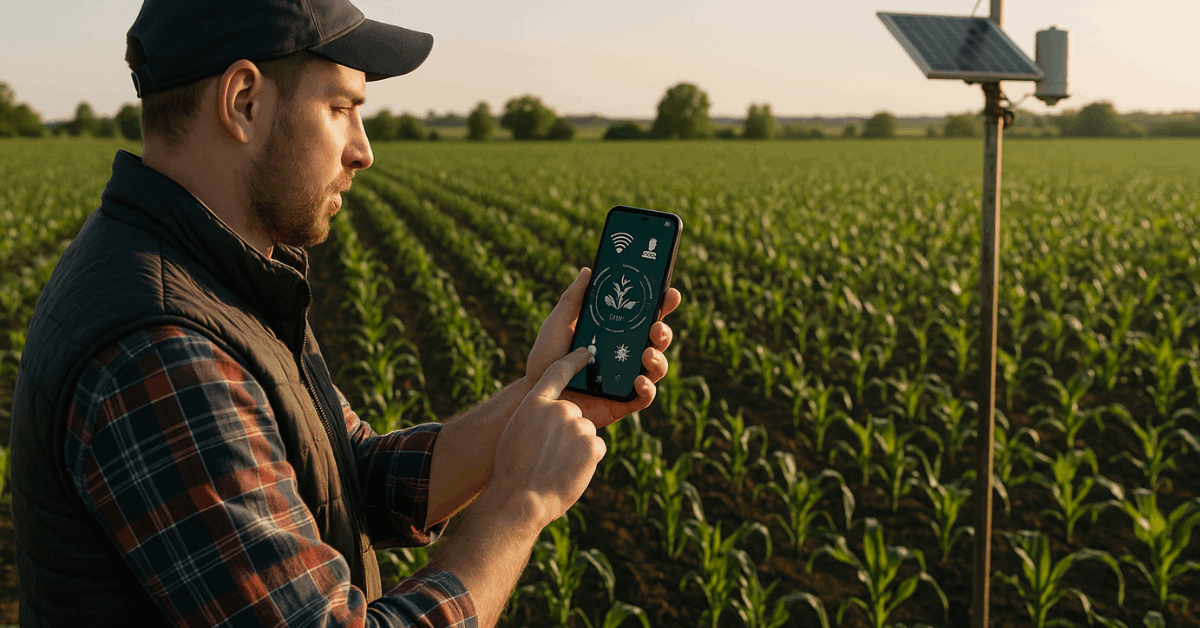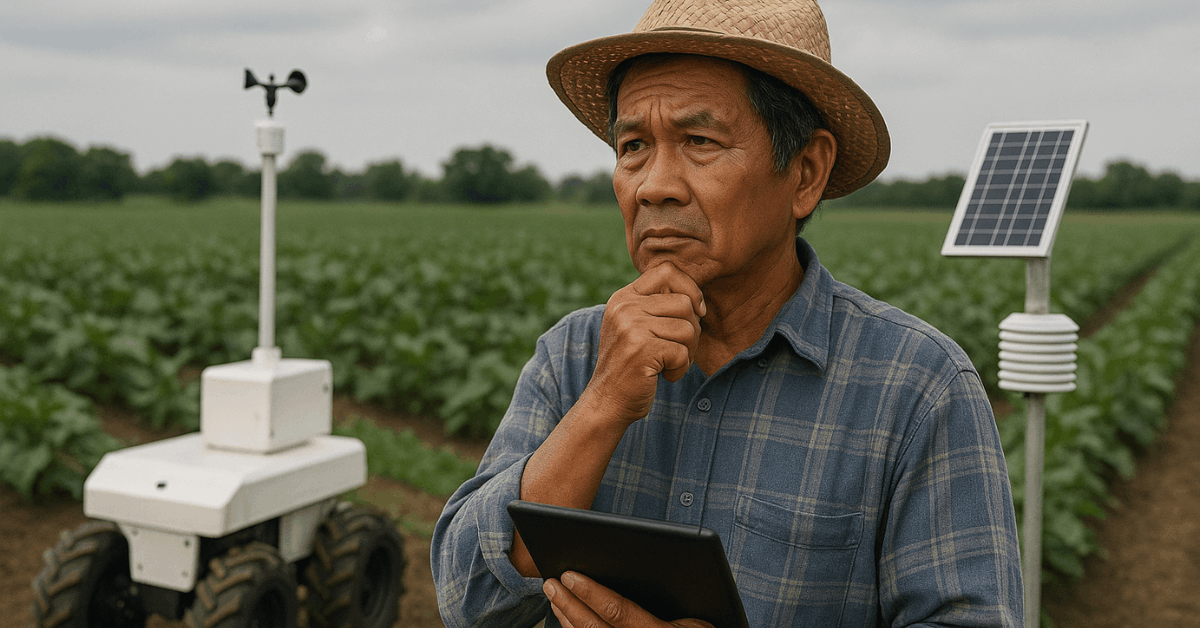Smart farming is changing the way food is produced. It uses modern technology to increase efficiency, productivity, and sustainability.
This article explores how these innovations are reshaping agriculture. From data-driven decisions to AI-powered machines, smart farming is revolutionizing global food systems.
What Is Smart Farming?
Smart farming refers to the integration of advanced technology into agriculture. It involves using tools like sensors, GPS, AI, and robotics to improve productivity.
Farmers can now monitor conditions and make decisions with real-time data. This level of precision was not possible with traditional methods.
Key Components of Smart Farming
Modern smart farming uses several interconnected tools. These technologies allow farms to operate more efficiently and with fewer resources. The following components are the backbone of smart agriculture:
- IoT sensors track soil moisture, temperature, and crop health.
- AI algorithms analyze data to guide planting and harvesting.
- Robotics automate tasks like weeding, watering, and harvesting.
- Cloud platforms store and process agricultural data.
How Smart Farming Works?
Smart farming operates by combining field data and automated systems. These systems respond instantly to changes in the environment. As a result, farmers can act quickly to optimize conditions and reduce waste.
Real-Time Data Collection and Action
Sensors installed in fields gather continuous data. Weather, soil, and crop conditions are measured accurately.
This data feeds into AI software that analyzes patterns and provides suggestions. Machines can then act automatically based on these instructions.
Mobile and Remote Access
Smart farming apps give farmers full control over their operations. With a smartphone, they can monitor and manage fields from anywhere.

Alerts are sent if conditions fall outside set limits. This approach reduces labor costs and human error.
Benefits of Smart Farming
Smart farming brings multiple advantages. It not only boosts productivity but also reduces negative environmental impacts. Farmers gain better insights, and consumers receive safer, higher-quality products.
Higher Yields and Quality
Precision farming means crops receive exactly what they need. Fertilizer, water, and sunlight are optimized at each stage.
This leads to faster growth and fewer crop failures. Quality improves due to better pest and disease control.
Lower Input Costs
By using resources only when needed, farms save money. Less water, fertilizer, and fuel are used. Machines are more efficient than manual labor. These savings increase profitability.
Sustainable Agriculture
Smart farming supports eco-friendly practices. Emissions are reduced with cleaner operations.
Data helps avoid over-farming and soil degradation. Sustainability improves across the entire food production chain.
Emerging Technologies in Food Production
Technology is at the core of smart agriculture. From field mapping to harvest automation, the tools involved are rapidly evolving. Each innovation is designed to solve specific farming challenges.
Drones and Aerial Imaging
Drones provide a bird’s-eye view of farmland. They can map areas and monitor crop health.
Aerial imaging reveals pests, diseases, or irrigation problems. These insights enable faster and more targeted responses.
Robotics and Automation
Autonomous machines perform repetitive tasks with precision. Tractors can drive themselves using GPS guidance.
Robots handle planting, pruning, and harvesting. Labor shortages are addressed by these reliable machines.
Internet of Things (IoT)
IoT devices connect all parts of the farm. Sensors talk to machines and apps in real time. Farmers receive alerts and summaries automatically. This connectivity enhances control and coordination.
Artificial Intelligence and Big Data
AI analyzes massive amounts of farm data. It finds trends and makes accurate predictions.
Decisions are backed by real science, not guesswork. Farmers become more proactive instead of reactive.
Smart Greenhouses and Vertical Farming
Not all farms are outdoors. Technology also supports food production in controlled environments. These methods allow for year-round farming in urban or extreme climates.
Controlled Environment Agriculture (CEA)
Smart greenhouses use sensors to manage the climate. Temperature, light, and humidity are constantly adjusted.
Crops grow in ideal conditions without pesticides. Productivity per square meter is much higher.
Vertical Farming Systems
Vertical farming stacks crops in layers. It uses hydroponics or aeroponics instead of soil.
LED lights simulate sunlight for efficient growth. With IoT integration, systems are fully automated.
Challenges in Smart Farming Adoption
Despite its advantages, smart farming faces several barriers. These issues slow down adoption, especially in rural and low-income areas. Addressing these gaps is key to future growth.
High Upfront Costs
Smart equipment can be expensive to purchase. Small-scale farmers may struggle to afford sensors or AI tools.
Financial support and scalable solutions are needed. Costs must become more accessible.
Skills and Knowledge Gaps
Many farmers lack the training to use advanced tools. Digital literacy is a barrier to implementation.

Educational programs and support centers can help. Bridging this gap is essential for success.
Connectivity and Data Security
Some rural areas have poor internet access. Smart systems depend on strong connectivity. Data privacy is also a concern for many users. Secure networks and regulations are required.
The Future of Smart Farming
As technology evolves, smart farming will expand further. Innovations will address existing barriers and boost food security. The next decade holds promise for global agriculture.
Investment and Agri-Tech Startups
More investors are funding agricultural innovation. Startups create scalable solutions for all farm sizes. Governments are also supporting research. The ecosystem is growing quickly.
Blockchain and Transparency
Blockchain ensures that food is traceable from farm to table. Consumers can see where their food comes from. Smart contracts automate supply chain agreements. This builds trust and efficiency.
How Artificial Intelligence Will Change Education and Farming?
AI can educate farmers through personalized tools. Mobile apps offer lessons on pest control or irrigation.
Machine learning tailors advice to specific crops. Education becomes more accessible and efficient.
Consumer Benefits of Smart Farming
Smart farming doesn’t just help producers. It also improves outcomes for consumers. The food system becomes safer, more stable, and more transparent.
Food Quality and Safety
Sensors detect spoilage and contamination early. Smart systems prevent unsafe products from reaching stores. Less pesticide use leads to cleaner produce. Consumers enjoy healthier options.
Food Price Stability
Predictable yields help stabilize prices. Automated systems reduce waste in storage and transport. Efficient farms can sell at better rates. Food supply chains become more reliable.
Smart Farming Is the Future of Food
Smart farming is changing the way food is grown and distributed. It increases yield, improves quality, and protects the environment.
Farmers, consumers, and the planet all benefit. Embracing this technology is key to building a more sustainable future.



